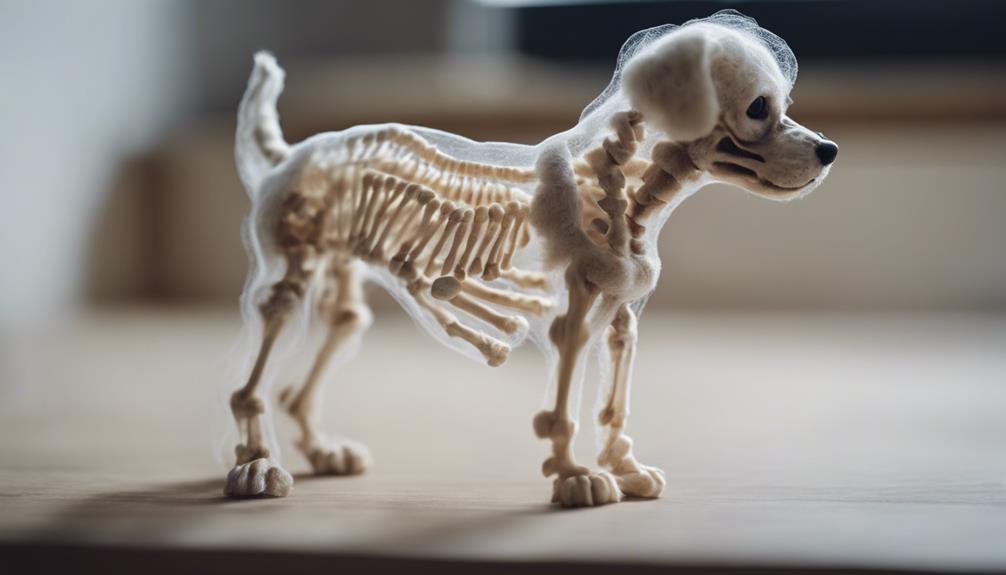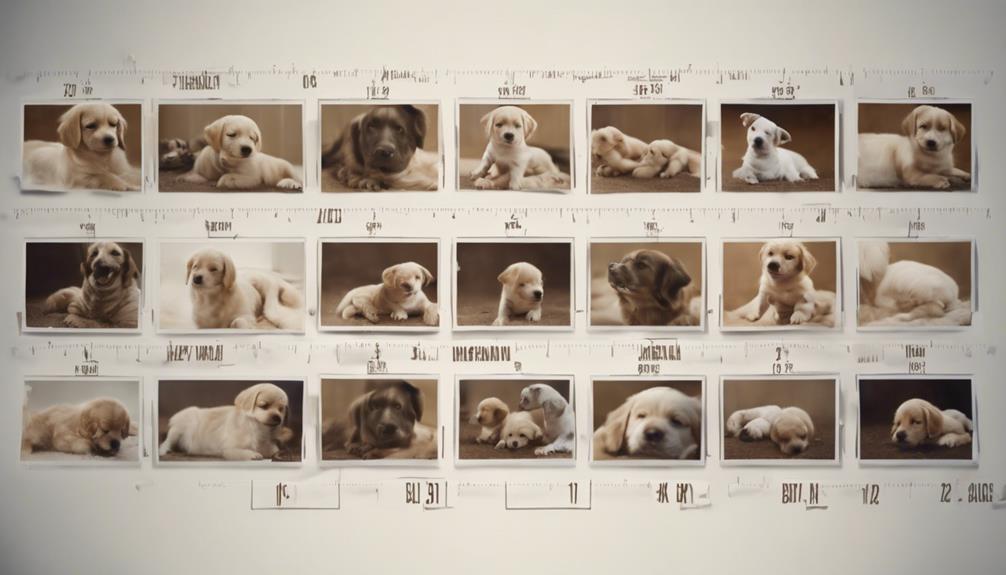In the realm of canine reproduction, the duration of pregnancy unfolds as a fascinating journey marked by distinct stages and developments. As dog owners and breeders navigate through the nine-week timeline of gestation, a closer examination of each week reveals a cascade of transformations within the expectant mother.
From the initial moments of conception to the crucial signs heralding the impending labor, a week-by-week exploration of canine pregnancy unveils a tapestry of growth and preparation that captivates the keen observer. Understanding the intricacies of this process not only enriches our knowledge but also underscores the importance of attentive care and vigilance throughout the entire gestational period.
Key Takeaways
- Dogs are pregnant for about 9 weeks, experiencing crucial events like breeding, fertilization, and embryo implantation.
- Embryos develop rapidly, forming distinct structures and organs, increasing in size significantly.
- Mid-pregnancy stages see active fetuses with developing features and organs, requiring increased nutrition for growth.
- Signs of impending labor include physical changes, nesting behavior, and preparation for a safe and comfortable birthing environment.
Early Pregnancy Stages
During the early stages of pregnancy in dogs, crucial events such as breeding, fertilization, and embryo implantation take place. After successful mating, the process of fertilization occurs when the male's sperm meets the female's egg, forming a zygote.
This zygote then travels down the oviduct and undergoes several cell divisions, becoming a morula and eventually a blastocyst. The blastocyst then implants into the uterine lining, initiating the development of the placenta and embryo.
This stage is vital for establishing a successful pregnancy, as proper implantation ensures the necessary nutrients and support for the developing embryo. Understanding these early pregnancy stages is key to ensuring the health and well-being of both the mother dog and her potential litter.
Week One: Breeding and Fertilization
In the initial phase of a dog's pregnancy, the process of breeding and fertilization marks the commencement of a significant reproductive journey for the mother canine. During this week, when a female dog is in heat, she becomes receptive to a male dog for breeding.
The mating process typically lasts for a few minutes but can occur multiple times to increase the chances of fertilization. Once mating takes place, the male dog's sperm fertilizes the female dog's eggs within her reproductive tract. This fertilization event initiates the formation of embryos that will eventually develop into puppies.
It is crucial for owners to monitor this initial stage closely to ensure successful conception and a healthy pregnancy progression.
Week Two: Embryo Implantation
Embryo implantation in dogs marks a critical stage in the early pregnancy process. During week two of pregnancy, fertilized embryos travel through the uterine horns and attach to the uterine lining. This process is essential for establishing a connection between the embryos and the mother's bloodstream, allowing for proper nutrient and oxygen exchange to support the growing fetuses.
As the embryos implant, they begin to develop rapidly, with cells differentiating to form various tissues and organs. While there are no outward physical signs of pregnancy during this week, it is a crucial time for the successful progression of the pregnancy. Owners should ensure the mother receives proper nutrition and care to support the early stages of fetal development.
Week Three: Continued Embryo Development
The progression of pregnancy in dogs advances into the third week with ongoing development of the embryos. During this week, significant changes continue to occur as the embryos grow and develop inside the female dog. Here is a detailed breakdown of what happens during week three:
| Week Three: Embryo Development | |
|---|---|
| Development | Embryos grow rapidly and start to form distinct structures |
| Size | Around the size of a sesame seed |
| Changes | Differentiation of tissues and organs begin |
This week marks a crucial stage in the pregnancy journey, laying the foundation for the further growth and maturation of the embryos as they progress towards becoming fully developed puppies.
Mid-Pregnancy Stages
During the mid-gestation period of canine pregnancy, significant developmental milestones occur as the growing embryos transition into fully formed fetuses.
Key Points:
- Increased Movement: The growing embryos become more active, and their movements may be felt by gently palpating the female dog's abdomen.
- Organ Development: Organs such as the heart, liver, and kidneys continue to develop, with some becoming functional during this stage.
- Appearance Changes: The fetuses start to take on a more recognizable form, with the development of distinct features like limbs, tails, and facial structures.
These mid-pregnancy stages mark a crucial period where the embryos transform into fetuses, setting the foundation for further growth and development in the coming weeks.
Week Four: Growing Embryos
In the midst of the mid-pregnancy stages of canine gestation, a notable evolution occurs as the embryos in the female dog's womb progress in growth and development during Week Four. At this stage, the growing embryos start to become more defined, and their size increases significantly.
It is during Week Four that the heartbeats of the embryos can be detected through advanced means, marking a crucial milestone in their development. Additionally, the female dog may exhibit an increased appetite as her body works to support the growing embryos.
This period is crucial for the proper formation of the puppies-to-be, laying the foundation for the subsequent stages of gestation.
Week Five: Transition to Fetuses

Transitioning from Week Four, Week Five marks a significant phase in canine gestation as the growing embryos in the female dog's womb undergo a crucial metamorphosis into fully formed fetuses. During this week:
- Organ Development: The embryos start to grow organs, laying the foundation for the puppies' future functionality.
- Visible Belly Changes: The female dog's belly becomes noticeably larger as the fetuses continue to develop, making her pregnancy more evident.
- Increased Nutritional Needs: As the embryos transition to fetuses, the female dog's nutritional requirements increase to support the growing puppies and their developing systems.
Late Pregnancy Stages
As canine gestation progresses into the late stages of pregnancy, notable physical changes become more pronounced in the female dog, signaling the imminent arrival of her litter. By week seven, signs of impending labor start to show, such as nipple changes, shedding of hair, and the visible presence of the fetuses within the mother's enlarged belly.
The female dog may display increased restlessness and seek out nesting areas as she prepares for whelping. It is crucial for owners to monitor her closely during this period, ensuring she is comfortable and providing a clean birthing environment. Additionally, preparing for the birth includes observing the mother's temperature for labor cues and being ready to assist if needed, allowing nature to take its course during the whelping process.
Week Six: Coat and Skeleton Development

During the sixth week of a dog's pregnancy, significant developments occur in the coat and skeleton of the growing fetuses. This stage marks crucial advancements that contribute to the overall growth and preparation of the puppies for birth.
- Coat Development: The fetuses' fur begins to form, signaling the initial stages of their external appearance.
- Skeleton Maturation: The skeletal structure of the puppies solidifies and continues to develop, laying the foundation for their future mobility and strength.
- Increased Fetal Growth: As the coat and skeleton progress, the fetuses experience significant growth in size and weight, becoming more recognizable as future puppies.
Week Seven: Signs of Impending Labor
In the seventh week of a dog's pregnancy, noticeable signs begin to manifest, indicating the impending arrival of labor. Some common signs include changes in the nipples, hair shedding, and visible fetuses. These physical changes signal that the mother dog is preparing for birth. It's essential for dog owners to monitor these signs closely to ensure a safe and smooth delivery process. Below is a table outlining these signs for a quick reference:
| Signs of Impending Labor | Description |
|---|---|
| Changes in Nipples | Nipples may become enlarged and more prominent |
| Hair Shedding | Increased shedding of hair as labor approaches |
| Visible Fetuses | Fetal movement may be visible under the skin |
| Nesting Behavior | Mother dog may start creating a nest for birth |
| Restlessness | Increased anxiety or restlessness in the mother |
Preparing for Birth

Preparation for the imminent birth of puppies involves creating a comfortable and hygienic birthing environment for the mother dog. To ensure a smooth and safe delivery, consider the following:
- Nesting Area: Provide a warm and quiet space where the mother dog can nest and feel secure during labor.
- Cleanliness: Keep the whelping area clean and sanitized to reduce the risk of infections for both the mother and puppies.
- Whelping Supplies: Gather necessary supplies such as clean towels, heating pads, a whelping box, and contact information for a veterinarian in case of emergencies.
Week Eight: Puppies Fully Developed
At Week Eight of a dog's pregnancy, the puppies have reached full development, positioning themselves within the birth canal in preparation for whelping. This stage marks a crucial milestone as the puppies are now fully formed with developed organs, limbs, and features.
The mother dog may exhibit nesting behaviors, preparing a comfortable space for the impending birth. It is essential to provide her with a calm and secure environment during this time. Monitoring her closely for any signs of distress or complications is crucial.
With the puppies now in position for birth, it is important to be vigilant and prepared for the upcoming whelping process in the following weeks.
Week Nine: Monitoring for Labor Signals

Monitoring the female dog's temperature and observing for specific physical and behavioral changes are essential practices during Week Nine of her pregnancy to anticipate labor signals efficiently. This crucial stage requires careful attention to ensure a smooth delivery process.
Here are three key points to consider during Week Nine:
- Temperature Monitoring: Regularly check the female dog's temperature using a rectal thermometer. A significant drop in temperature (below 100°F) may indicate that labor is imminent.
- Behavioral Changes: Watch for signs of restlessness, nesting behavior, or seeking seclusion. These behavioral changes can signal that the female dog is preparing for labor.
- Physical Signs: Keep an eye out for vaginal discharge, panting, and contractions. These physical signs indicate that labor is progressing, and the puppies will soon arrive.
Conclusion
In conclusion, understanding the duration and progression of canine pregnancy is essential for dog owners and breeders to provide proper care and support for the expecting mother and her developing litter.
By monitoring the week-by-week stages of gestation, individuals can prepare for labor signs and ensure the well-being of both the pregnant dog and her puppies.
This comprehensive guide offers valuable insights into the intricate process of canine pregnancy, equipping readers with the knowledge needed to navigate this transformative journey.




